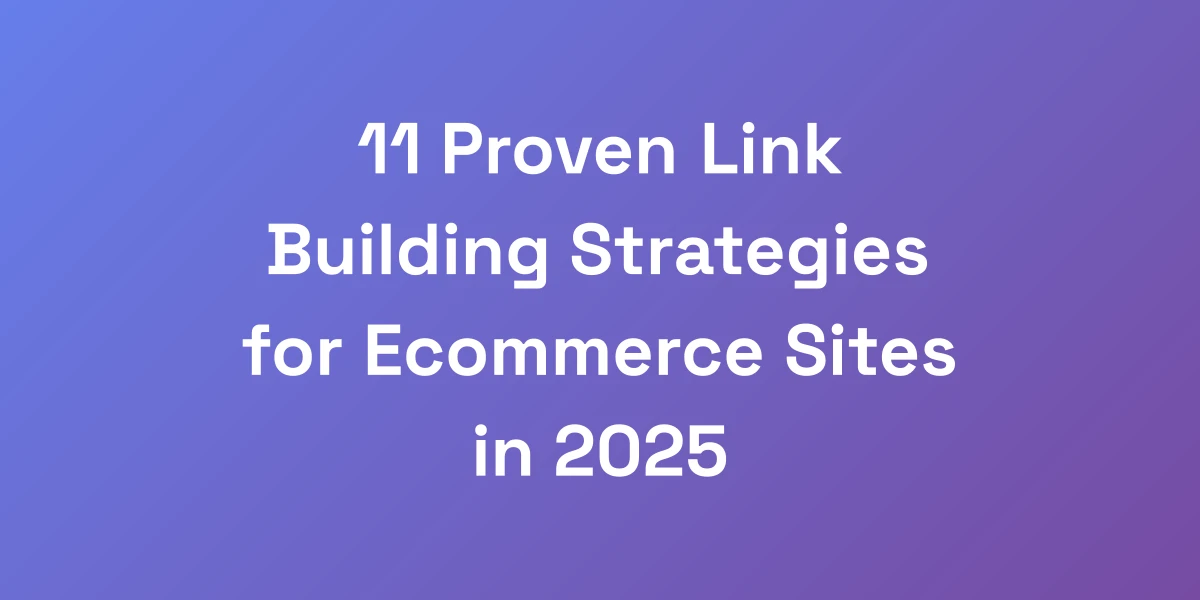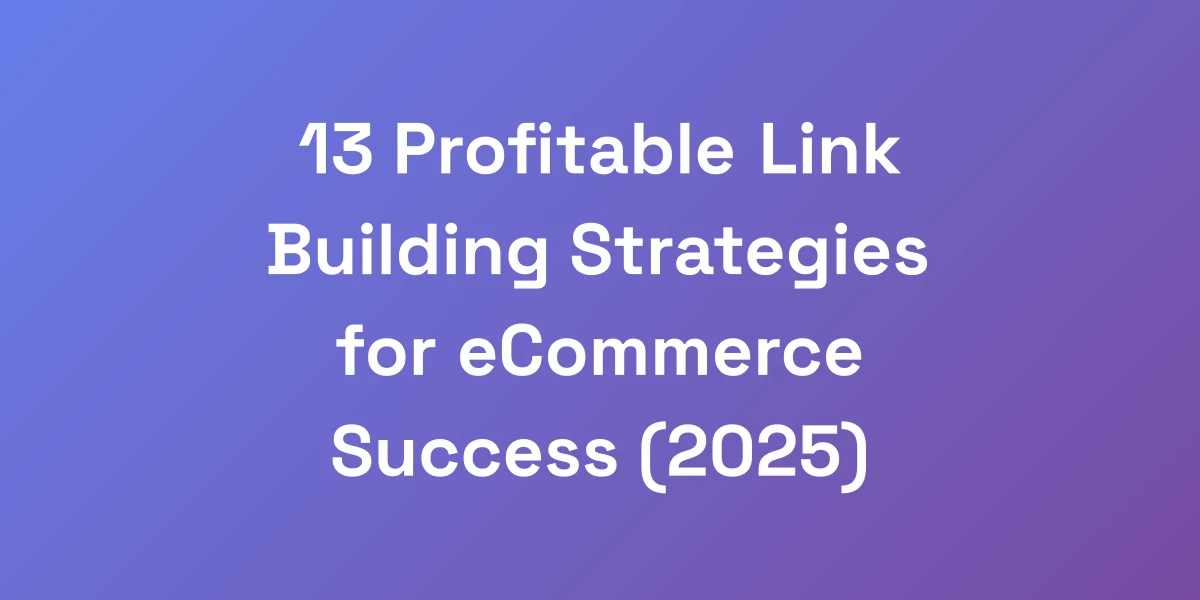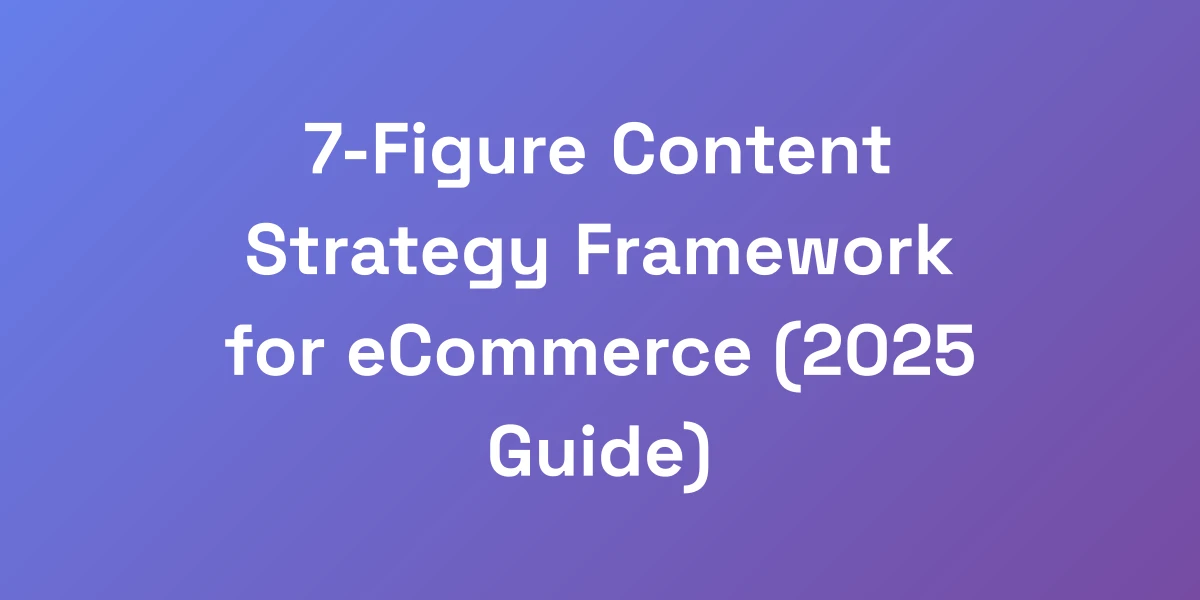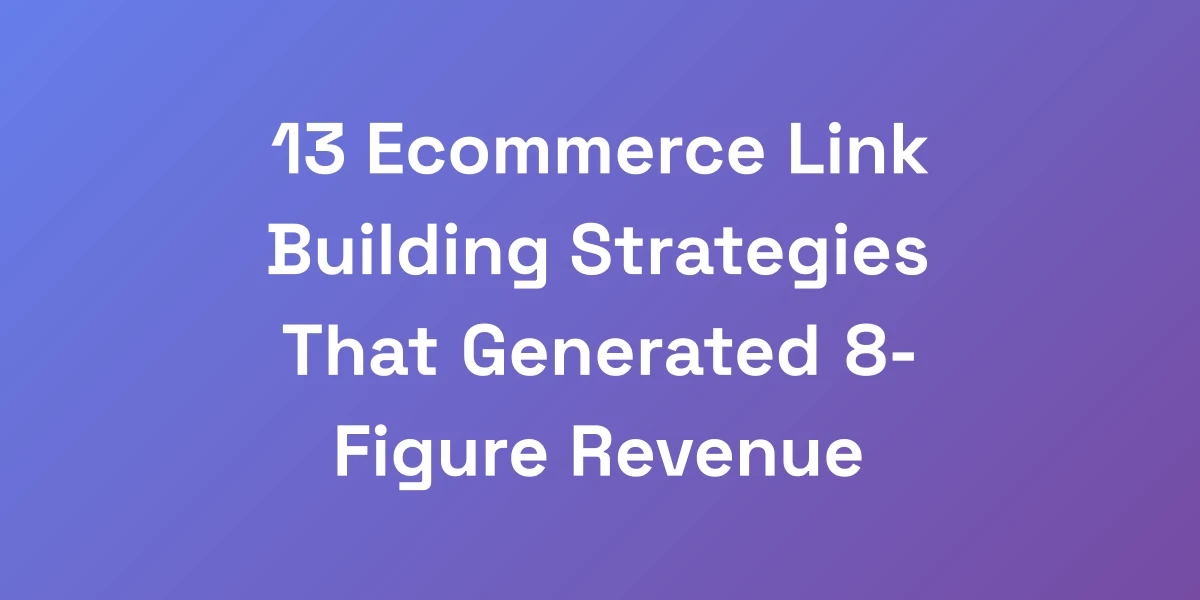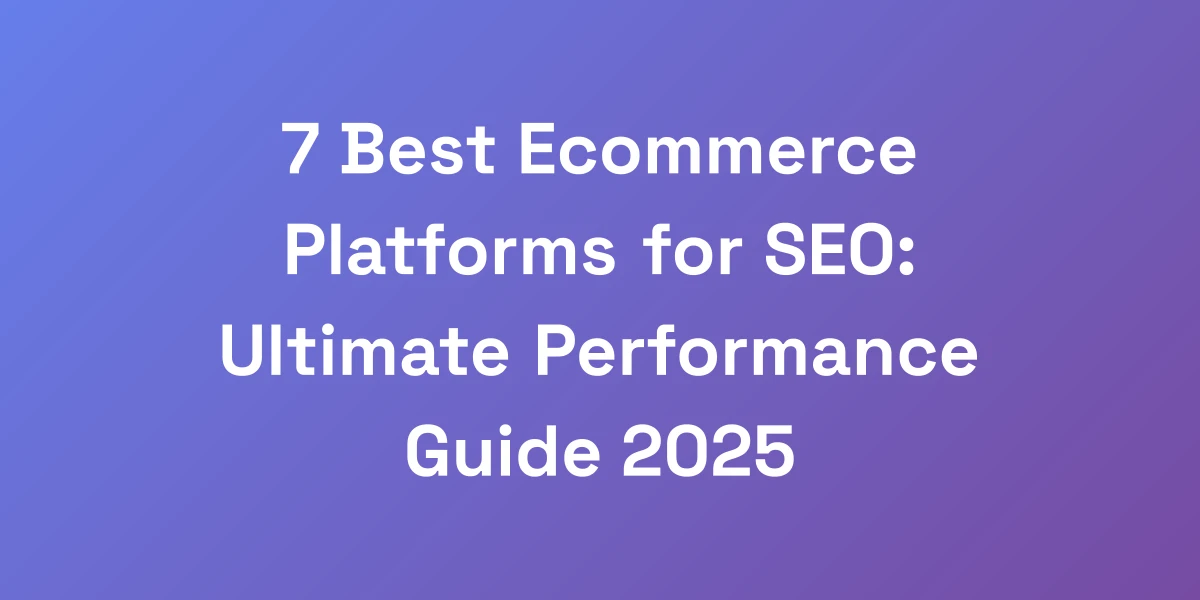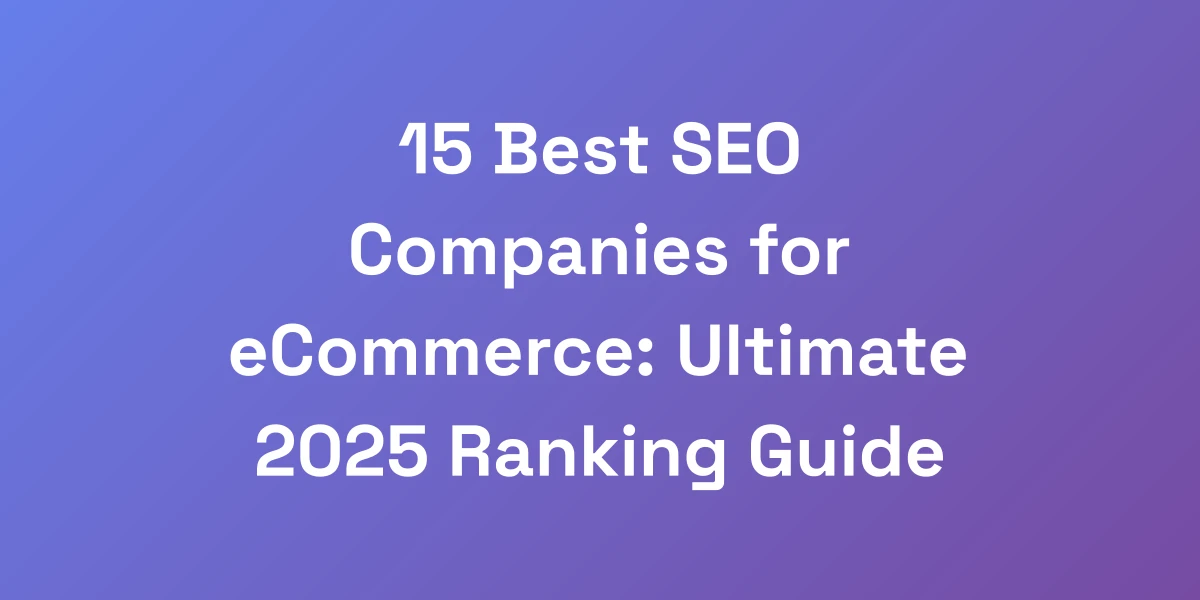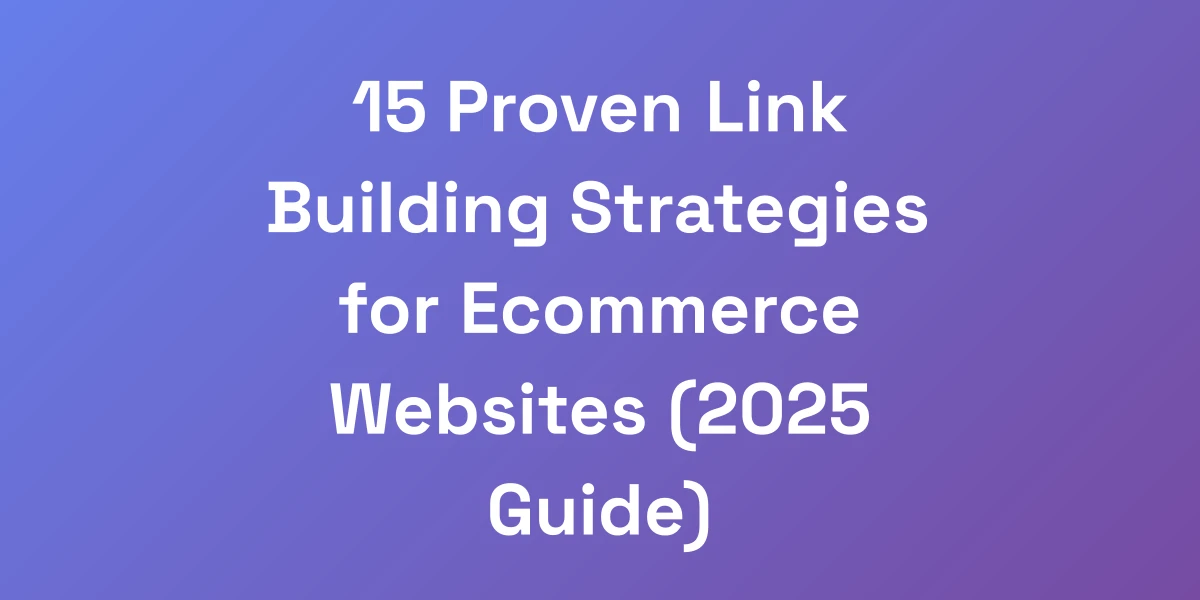
15 Proven Link Building Strategies for Ecommerce Websites (2025 Guide)
Mar 5, 2025 | By [email protected]
Why Traditional Link Building Fails Ecommerce Websites
Let’s cut through the BS – most link building advice doesn’t work for ecommerce. Why? Because they’re designed for blogs and media sites, not product pages.
We’ve spent millions testing what actually moves the needle for ecommerce SEO. The truth? You need a completely different playbook.
Your product pages aren’t naturally linkable. Your category pages look like every other store. And your blog? It’s probably collecting dust.
But here’s the thing – when you understand the real mechanics of ecommerce link building, you can turn these challenges into massive opportunities.
The Unique Challenges of Ecommerce Link Building
Ecommerce sites face unique hurdles when it comes to link building. Unlike blogs that thrive on content sharing, ecommerce platforms primarily focus on product sales. This means your pages aren’t inherently designed to attract backlinks.
Product pages usually lack the in-depth content that naturally attracts links. They often feature repetitive descriptions and similar layouts, making them less appealing to linkers. Additionally, the competitive nature of ecommerce means you’re up against countless other sites vying for the same backlinks.
Understanding these challenges is the first step in developing a strategy that turns your ecommerce site into a link magnet.
Why Most Ecommerce Sites Fail at Attracting Links
Most ecommerce sites falter because they treat link building as an afterthought. They rely on basic tactics like listing their products and hoping someone notices.
But let’s be real – if you’re just hoping for the best, you’re setting yourself up for failure. Ecommerce link building requires proactive strategies tailored to the nuances of online retail. Failing to recognize this often results in stagnant backlink profiles and missed SEO opportunities.
Moreover, many ecommerce sites lack the resources or know-how to implement advanced link building techniques, leading to ineffective efforts and wasted budgets.
The Real Cost of Poor Link Building Strategy
Investing in a poor link building strategy can be disastrous for your ecommerce site. Not only does it waste valuable resources, but it can also harm your SEO efforts.
Low-quality or irrelevant backlinks can lead to penalties from search engines, dragging down your site’s authority and rankings. Furthermore, missed opportunities mean less organic traffic and, ultimately, lower sales.
In the competitive ecommerce landscape, having a robust and effective link building strategy is not just an option – it’s a necessity.
Understanding the Ecommerce Link Building Ecosystem
To master ecommerce link building, you need to understand the ecosystem in which it operates. This involves recognizing the key players, trends, and dynamics that influence how links are acquired and valued.
Ecommerce link building isn’t just about acquiring links; it’s about building relationships with influencers, leveraging user-generated content, and creating valuable assets that others naturally want to link to.
By comprehending the broader ecosystem, including SEO for startups, you can develop strategies that are not only effective but also sustainable in the long run.
Setting Realistic Link Building Goals for Your Store
Setting realistic goals is crucial for any successful link building campaign. It’s not just about acquiring as many links as possible but about obtaining the right kinds of links that drive meaningful results.
Consider metrics like the authority of linking domains, the relevance of the content, and the potential traffic each backlink can bring. These factors will help you prioritize your efforts and achieve a higher ROI.
Remember, in ecommerce link building, quality trumps quantity every time.
High-Impact Link Magnets for Ecommerce Websites
Here’s the brutal truth about ecommerce link building – you need assets that FORCE people to link to you. I’m not talking about generic blog posts or basic product descriptions.
I’m talking about creating content so valuable, so unique, that industry players can’t ignore it. The secret? Understanding what triggers natural linking behavior in your niche.
When you nail this, you’ll have websites begging to link to you, not the other way around. Let me show you exactly how to create these link magnets that practically build links while you sleep.
Creating Industry-Leading Buying Guides
Developing comprehensive buying guides can position your ecommerce site as an authority in your industry. These guides are a form of business blogging that should offer in-depth information about products, helping customers make informed decisions.
For instance, a tech store could create a detailed guide on choosing the best smartphone, covering various features, comparisons, and user needs. Such content is highly valuable and likely to be linked by other websites seeking reliable information to share with their audience.
- Actionable Tip: Include high-quality images, comparison charts, and expert opinions to enhance the credibility and usefulness of your guides.
- Example: REPRESENT CLO’s success with their detailed luxury clothing guides doubled their organic traffic, showcasing the power of well-crafted buying guides.
Developing Original Research and Data Studies
Original research and data studies are gold mines for link building. By conducting unique research relevant to your niche, you provide valuable insights that others in the industry will reference and link to.
Imagine conducting a survey on consumer preferences in your market or analyzing trends over time. These studies can become authoritative resources that attract backlinks from industry publications, blogs, and news sites.
- Actionable Tip: Promote your research through press releases, social media, and direct outreach to maximize visibility and backlink potential.
- Case Study: BlueMagic Group increased their Domain Rating by four notches through targeted data-driven link building campaigns, highlighting the effectiveness of original research.
Building Interactive Tools and Calculators
Interactive tools and calculators engage users and provide immediate value, making them perfect link magnets. These tools solve specific problems or answer common questions within your niche.
For example, a home improvement store could create a tool that helps users estimate the amount of paint needed for a project. Such practical utilities are not only useful but also highly shareable, attracting backlinks from various sources.
- Actionable Tip: Ensure your tools are user-friendly, mobile-optimized, and provide accurate, reliable results to encourage widespread use and sharing.
- Example: Developing a unique ecommerce calculator can lead to natural backlinks from blogs and websites that recommend practical tools to their audience.
Crafting Viral-Worthy Visual Content
Visual content like infographics, videos, and high-quality images can significantly boost your link building efforts. These assets are easily shareable and can convey complex information in an engaging way.
Create visuals that present data, tell a story, or offer valuable insights in a visually appealing format. When done right, these visuals become go-to resources that others want to feature and link to.
- Actionable Tip: Use vibrant colors, clear typography, and concise information to make your visuals stand out and be more shareable.
- Example: Lululemon’s “Dupe Swap” visual campaign generated millions of views and numerous viral marketing campaigns by tapping into trending topics and leveraging user-generated content.
Leveraging User-Generated Content for Links
User-generated content (UGC) not only fosters community engagement but also serves as a powerful link building tool. Encourage your customers to create content related to your products, such as reviews, testimonials, and social media posts.
This content adds authenticity and can attract backlinks naturally as others share or reference user experiences.
- Actionable Tip: Feature UGC prominently on your site and provide incentives for customers to share their content, boosting both engagement and backlink potential.
- Example: Encouraging customers to share their Lululemon dupe swaps led to viral content that attracted numerous backlinks and enhanced brand visibility.
Strategic Outreach Tactics That Actually Convert
Stop sending those garbage template emails that everyone ignores. Your outreach needs to be as strategic as your product pricing.
We’ve tested thousands of outreach campaigns, and we can tell you exactly what works in the ecommerce space.
The key? Creating a value proposition that makes linking to you a no-brainer for your targets. When you combine the right targeting with irresistible offers, your response rates will skyrocket from 2% to 20%+.
Building Relationships with Industry Influencers
Building strong relationships with industry influencers can open doors to high-quality backlinks. Influencers often have established audiences and can amplify your content’s reach.
Start by engaging with influencers on social media, sharing their content, and offering genuine value before pitching collaboration ideas.
- Actionable Tip: Personalize your outreach by referencing specific aspects of the influencer’s work and explaining how a partnership can benefit both parties.
- Example: Collaborating with influencers like Nicky Doll for Aspercreme’s campaign resulted in millions of views and substantial backlink gains.
Leveraging Competitor Backlink Analysis
Analyzing your competitors’ backlink profiles can uncover valuable link opportunities. Tools like best automated link building tools allow you to see where your competitors are getting their links and identify gaps you can exploit.
Focus on acquiring links from the same high-authority domains that are linking to your competitors but not to you yet.
- Actionable Tip: Create a list of potential backlink sources based on competitor analysis and prioritize them based on authority and relevance.
- Example: By identifying and targeting backlinks from sites that linked to BlueMagic Group, we were able to significantly improve their Domain Rating and traffic.
Creating Win-Win Partnership Opportunities
Forming strategic partnerships with other businesses can be mutually beneficial for link building. Look for companies that complement your products without directly competing with them.
These partnerships can lead to collaborative content, co-hosted events, or cross-promotional campaigns that naturally generate backlinks.
- Actionable Tip: Identify potential partners within your industry and propose partnership ideas that offer clear benefits to both parties.
- Example: REPRESENT CLO’s partnership with complementary brands led to shared content and increased backlinks from relevant, high-authority sites.
Mastering Email Outreach Templates
Email outreach is an art form that can make or break your link building efforts. Crafting compelling emails that grab attention and convey clear value is essential.
Your outreach emails should be personalized, concise, and offer something valuable to the recipient. Avoid generic templates that feel impersonal and spammy.
- Actionable Tip: Use a compelling subject line, introduce yourself briefly, explain the value of the link, and provide a clear call to action.
- Example: Personalized outreach emails sent to targeted influencers and bloggers resulted in a significant increase in positive responses and backlinks.
Following Up Without Being Annoying
Following up is crucial in outreach, but it must be done thoughtfully. Too many follow-ups can be annoying, while too few can result in missed opportunities.
Space out your follow-ups and ensure each one adds value or a new piece of information. This approach keeps the conversation fresh and increases the chances of a positive response.
- Actionable Tip: Develop a follow-up schedule that includes 2-3 touches over a couple of weeks, each with a unique angle or additional value proposition.
- Example: A strategic follow-up sequence helped BlueMagic Group secure multiple high-quality backlinks, enhancing their SEO performance significantly.
Advanced Link Building Techniques for Ecommerce
Want to know what separates 7-figure stores from the rest? It’s not just about building links – it’s about building the right links that drive actual revenue.
We’re going to show you advanced techniques that most SEOs don’t even know exist. These aren’t your typical guest post strategies.
These are proven methods that have generated millions in additional revenue for our ecommerce clients through strategic link placement and anchor text optimization.
Broken Link Building for Product Pages
Broken link building involves finding broken links on other websites and offering your content as a replacement. This technique is particularly effective for ecommerce product pages.
Identify broken links related to your products, reach out to the site owners, and suggest your product page as a viable replacement.
- Actionable Tip: Use tools like Ahrefs to find broken links in your niche and prioritize those from high-authority sites.
- Example: By replacing broken links with PRODUCT PAGES, ecommerce sites can gain valuable backlinks and improve their SEO rankings.
Digital PR Campaigns That Generate Links
Digital PR campaigns are a powerful way to generate high-quality backlinks and boost brand visibility. These campaigns involve creating newsworthy content or events that attract media attention.
From launching a unique promotion to conducting a viral marketing stunt, digital PR can significantly enhance your backlink profile.
- Actionable Tip: Develop a compelling story or event that aligns with your brand and resonates with your target audience to maximize media coverage.
- Case Study: Rise at Seven PR’s creative campaign for a fashion brand resulted in 60+ backlinks and a substantial boost in revenue.
Resource Page Link Building at Scale
Resource pages are curated lists of valuable content and tools within a specific niche. Getting listed on these pages can provide high-quality backlinks and drive targeted traffic to your ecommerce site.
Identify relevant resource pages within your industry and reach out to the webmasters with a compelling case for including your resources.
- Actionable Tip: Create a dedicated resource page on your site showcasing your best content, tools, and products to make it easier for others to link to you.
- Example: Featuring a comprehensive resource page can attract links from educational sites, industry blogs, and partner companies.
Leveraging HARO and Media Opportunities
HARO (Help A Reporter Out) is a platform that connects businesses with journalists seeking expert insights. By responding to relevant queries, you can earn high-quality backlinks from reputable media outlets.
Additionally, actively seeking media opportunities for interviews, guest appearances, and expert commentary can further enhance your backlink profile.
- Actionable Tip: Set up alerts for HARO queries that match your expertise and respond promptly with valuable insights to increase your chances of getting featured.
- Example: Represent CLO’s proactive approach with HARO inquiries led to coverage from top industry publications, resulting in valuable backlinks and increased brand authority.
Local SEO Link Building for Ecommerce
For ecommerce businesses with a local presence, incorporating local SEO into your link building strategy is essential. Local backlinks from community websites, local influencers, and regional directories can boost your local search rankings.
Optimize your Google My Business profile, engage with local organizations, and sponsor local events to gain high-quality local backlinks.
- Actionable Tip: Partner with local businesses or charities to create joint initiatives that can earn backlinks from their websites and local media coverage.
- Case Study: Sofas 2 Furnishings achieved a 1,500 monthly visitor increase by optimizing local backlinks and ranking #1 in Google’s Map Pack for local keywords.
Measuring and Scaling Your Link Building Success
If you can’t measure it, you can’t improve it. But here’s the thing – most ecommerce owners are tracking the wrong metrics.
Forget about generic Domain Authority. We’ll show you the exact KPIs that matter for ecommerce link building and how to scale what’s working.
We’re talking about metrics that directly correlate with revenue growth, not vanity metrics that look good in reports but don’t move the needle.
Key Metrics for Link Building ROI
To accurately measure the success of your link building efforts, focus on metrics that directly impact your ecommerce business.
- Organic Traffic: Track the increase in organic visitors resulting from your backlink efforts.
- Referral Traffic: Monitor the traffic coming from specific backlinks to gauge their effectiveness.
- Conversion Rates: Analyze how referral traffic influences sales and conversions on your ecommerce site.
- Revenue Growth: Correlate backlink data with overall sales performance to determine ROI.
These metrics provide a clear picture of how your link building strategies are contributing to your business goals.
Tools for Tracking Link Building Progress
Utilizing the right tools is essential for tracking and optimizing your link building efforts. Tools like Ahrefs, SEMRush, and best automated link building tools offer comprehensive features to monitor backlinks, analyze competitor strategies, and manage outreach campaigns.
- Ahrefs: Extensive backlink analysis and competitor insights.
- SEMRush: Automated workflows and AI-driven email personalization.
- Linkody: Link health monitoring and change tracking.
These tools help you stay on top of your backlink profile and make data-driven decisions to enhance your SEO performance.
Scaling Successful Link Building Campaigns
Once you’ve identified strategies that yield positive results, it’s time to scale them. Scaling involves increasing the volume of link building activities while maintaining quality.
Automate repetitive tasks using marketing automation for agencies, expand your outreach efforts, and continuously refine your strategies based on performance data.
- Actionable Tip: Use automation tools to streamline your outreach process, allowing you to reach more potential link partners without sacrificing personalization.
- Example: By scaling their successful outreach campaigns, BlueMagic Group was able to multiply their organic traffic by seven times, showcasing the power of strategic scaling.
Avoiding Common Scaling Pitfalls
Scaling link building efforts isn’t without its challenges. Common pitfalls include sacrificing quality for quantity, neglecting relationship building, and failing to adapt to new SEO trends.
To avoid these pitfalls, maintain a strong focus on quality, nurture your relationships with link partners, and stay updated with the latest SEO best practices.
- Actionable Tip: Regularly audit your backlink profile to ensure the quality of your links remains high as you scale your efforts.
- Example: Maintaining quality while scaling helped ecommerce clients achieve sustainable growth without facing SEO penalties.
Creating a Sustainable Link Building System
A sustainable link building system ensures long-term success by institutionalizing effective strategies and continuous improvement.
Develop standardized processes for content creation, outreach, and relationship management. Implement regular reviews and adjustments based on performance data using SEO optimization automation tools and by incorporating SEO for freelancers to keep your link building efforts aligned with your business objectives.
- Actionable Tip: Document your successful link building strategies and train your team to execute them consistently.
- Example: Establishing a sustainable system allowed ecommerce sites to maintain a steady flow of high-quality backlinks, driving consistent traffic and revenue growth.
Conclusion
We’ve unpacked 15 proven link building strategies tailored specifically for ecommerce websites. From creating high-impact link magnets to mastering strategic outreach, each tactic is designed to overcome the unique challenges of ecommerce SEO.
Remember, link building is not a one-time effort but a continuous journey. By focusing on quality, relevance, and strategic execution, you can build a robust backlink profile that drives organic traffic, enhances your domain authority, and boosts revenue.
Ready to take your ecommerce site’s SEO to the next level? Start implementing these strategies today and watch your online presence soar.
Have questions or want to share your link building successes? Drop a comment below or reach out to us on social media. Let’s grow together!
